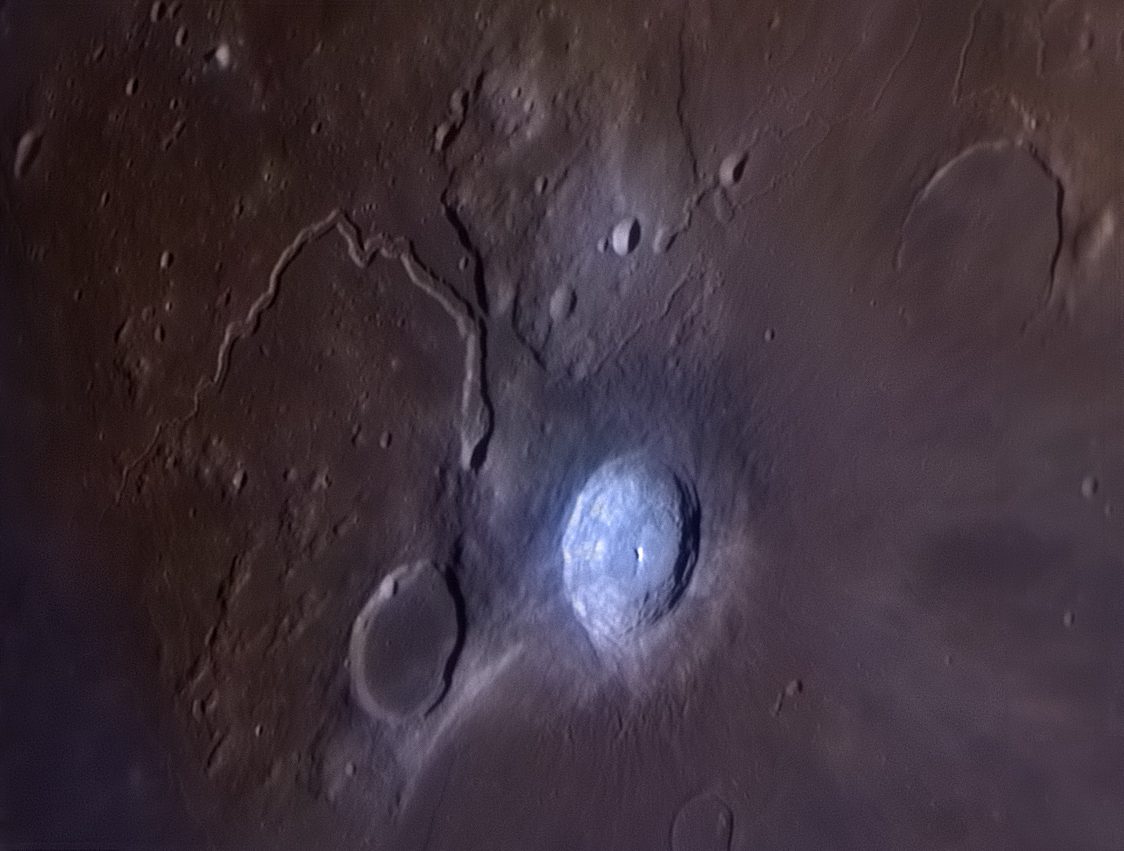
Caption: This region features one of the most unusual geological structures on the Moon, with a strange and complex landscape marked by ancient volcanism (Schröter's Valley, 3.6BYr) and a much younger impact crater (Aristarchus, 500MYr). These processes have given rise to significant variations in surface chemistry and age which can be revealed by enhancing subtle color variations present in the natural view. The area shown here is roughly 200 km across and the smallest visible craters are ~1km in diameter.
Conditions: no wind, no clouds, not much haze or fog; minus 13 deg.C -very cold!
Setup: Obsession 18" f4.5 Dobsonian telescope. High res mono image acquired with 4x Televue powermate, red filter, Lumenera Skynyx 2-2M camera (0.1 arcsec/pixel). Color image shot with a Nikon D300 DSLR and a 2x powermate (image)
Acquisition - Nikon D300: 1/200 sec exposure time, ISO 400, 14-bit digitalization, RAW format. Took 25 frames.
Acquisition - Skynyx 2-2M: 24 msec exposure time, gain 3.5 and 8-bit digitalization. Took 4000 frames over a period of five minutes through a red filter.
DSLR processing: This is one of the first times I am using a DSLR for lunar imaging - I have borrowed a Nikon D300 from my good friend, Henrik Bondo. I took 25 DSLR frames, hoping that I could process them like one normally does on image sequences from a video camera. This would increase sharpness and reduce noise - which I really would need for this project. However - initial inspection' showed that nearly all shots were severely affected by vibrations, even though (I think) I did use 1 second mirror-up to avoid this problem. Apparently, a two meter high Dobsonian with a heavy powermate and moderately large DSLR hanging on its front end is not a very stable platform! I wonder if a longer mirror-up time can somehow be used? Of the 25 DSLR frames only one was reasonably free from vibrations. This image I color enhanced three times 200% using MaxIm DL. (Hint: do not use Photoshop for this - it is vastly inferior to MaxIm!!)
Skynyx 2-2M processing: This evening was very cold and my alt-az tracking system on the Dob was not very happy. There was some jerky movement and I had to manually correct a lot just to keep the field of view centered. The resulting erratic movements are bad enough to confuse automatic alignment and stacking programs, so I have developed a (cumbersome!) method of manually noting down the position of some crater just before it makes a sudden jump, then using these numbers in a simple program to move the images in the opposite direction. Between measurements I use linear interpolation to get an estimate of the required shift for all images. It took several hours of manual labour to do this but the result seems like magic: suddenly it seems as if I had excellent tracking! I then used my new favorite alignment and stacking program - Autostakkert - to process the images. A total of 240 images were used in the final stack- the best 6%. Autostakkert saves an automatically sharpened image which I have always liked very much so I just used this after a bit of tweaking and noise reduction in Photoshop.
Color composite processing was done using Photoshop in much the same way as normally done. First the, color image was rotated and scaled to match the mono image. I did this by measuring ditances and angles of lines between four pairs of craterlets in each image. Then the color image was overlaid as a layer with 'color' blending mode on top of the mono layer. Suddenly, the black and white landscape comes to life with geochemical variations evidently displayed as pretty colors.
Here's my main page where you can see more of the pictures I have taken so far.
Comments greatly appreciated! (mikael@leif.org)